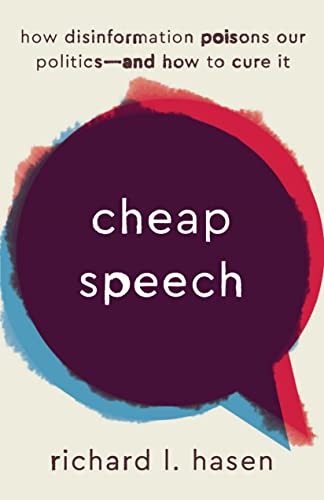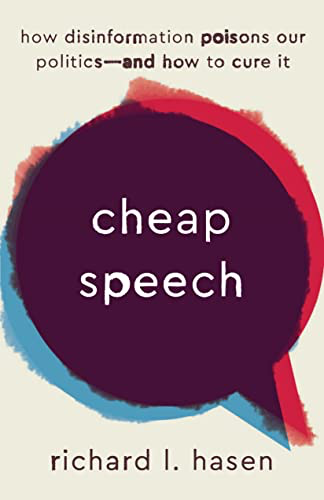Richard L. Hasen, Cheap Speech: How Disinformation Poisons Our Politics–and How to Cure It


Richard L. Hasen, Cheap Speech: How Disinformation Poisons Our Politics – and How to Cure It ( Yale University Press, 2022)
Professor Rick Hasen is in many ways the perfect person to write a book on the problems that the First Amendment to the U.S. Constitution are creating for American democracy in the internet age. He is an eminent scholar of both constitutional law and political science. He’s indefatigable and incredibly industrious, churning out books, articles, interviews, and news show punditry on a nearly daily basis. And he is sought out by the media because he is both thoughtful and comprehensible: while he is always searching for new and subtle ways in which either the Congress or the Courts can somehow save what’s left of electoral democracy in the U.S., he presents his ideas in ways that couch potatoes as well as future attorneys in the University of California system can fathom. Finally, he presents as a realist rather than a wild-eyed reformer. While he may want to see the end of the Electoral College or the Senate Filibuster, he doesn’t waste a lot of time dreaming the impossible dream out loud. The improvements for which he advocates are ostensibly marginal–though many are argued to be quite important. And the probability of the passage and retention of each proposed reform is dispensed soberly, with an eye to relevant precedents as well as the current makeup of both SCOTUS and Congress. In addition, while Hasen doesn’t downplay the importance of any of the changes sought, he calmly tries to distinguish those that are absolutely essential RIGHT NOW from those that it might be sensible to defer to a future date. And he has a keen sense for the difference between proposals that have legitimate chances of success and those whose enactment would require the luck of an exacta winner at the upcoming Belmont Stakes. He is, in a word, an author who has all the S’s covered: from smart, savvy, and scholarly, to straightforward, sedulous, and sensible.
But for all of this book’s–and its author’s—virtues, I can’t deny my misgivings. While I’ve described Hasen as a realist, there are several distinguishable varieties of political realism, so my reservations may just stem from my sense that there are one or two types that he either lacks or has generally preferred to downplay in his writings and oral commentary. And, at least in present day America, an accurate depiction of political reality seems to me to require deep pessimism of a kind not displayed in this book. I’ll try to explain what I mean by this bleak comment below, but as the main obligation of any merchandise reviewer is to provide prospective buyers (or readers) with a summary description of the item in question, I will first turn to that task.
The book is divided into four chapters; the first two describe the current susceptibility of democracy in the U.S. to attacks that are quite likely to cause government-by-the-people to disappear entirely, at least if steps are not taken ASAP. The dangers emanate from intentional dissemination of disinformation, something that can today be accomplished extremely cheaply and easily, in conjunction with a Congress and Supreme Court which lack strong majorities that care about this problem. The rest of the work is devoted to the suggestion of possible remedies, with Chapter 3 focusing on legislative/regulatory initiatives, and Chapter 4 providing a few home remedies that don’t involve the alteration or reinterpretation of any existing laws, though it is, of course, quite possible that some of them could engender suits by those with other ideas.
With respect to the opening chapters, I think it’s pretty clear that no one who doubts the seriousness or pervasiveness of the “cheap speech” problem in the U.S. is likely either to buy or to read this book, so the front sections might be considered gratuitous filler. When (i) perhaps 35% of the population of a country believes, without justification, that a presidential election has been stolen–in spite of the fact that nearly all of the scores and scores of suits alleging such electoral shenanigans have been thrown out of court for lack of evidence; and (ii) a substantial majority of that large minority seems utterly unphased even by an attempt at a violent coup (captured on film!) by blood-thirsty rioters making baseless allegations of election theft, the crisis of American democracy is surely quite obvious to that outraged 40ish% of the U.S. citizenry that includes every one of this book’s prospective readers. But in spite of the apparent gratuitousness of any enumeration of worries, Hasen meticulously documents how the well-known propensities of both lucre-seeking social media algorithms and conservative (i.e., regulation-hating) Supreme Court Justices are combining to broaden the power of those who care almost exclusively about winning elections by making it easier to dole out snake oil in quantities only dreamed of prior to the internet age.
Today, lies can be broadcast, videos can be doctored and widely disseminated, and conspiracy theories can be dangled in front of millions of gullible potential allies–all for pennies. And, sadly, these lies, altered videos, and absurd theories will be believed by multitudes, whether there is much credence to them or not, simply because lots of people WANT to believe, e.g., that an election was rigged, or that “the Jews” have a plan to “replace them” with Muslim immigrants, or that agents of Soros and Biden are coming to confiscate their guns. QAnon may have seemed quaint–even cute–when we first heard about Pizzagate, but that was before we’d also become familiar with these terms: “post-truth,” “Newsmax,” “OANN,” “Breitbart,” “hydroxychloroquine,” “antifa,” “Proud Boys,” “ivermectin,” and “Oath Keepers.” Today, nearly every prospective purchaser of Cheap Speech will have seen videos of people armed with AK-47s inside the Wisconsin State House or have watched the U.S. Capitol being broken into by a group intending to stop the counting of electoral votes and chanting their desire to murder the Vice President. So I’m guessing no careful recitation of the imminent dangers facing the U.S. is either necessary or particularly useful–especially among those who have learned that the failure of Hitler’s Beer Hall Putsch to topple the Weimar Republic was only a temporary setback. So let us instead concentrate on Hasen’s recommended fixes.
He begins by assuring us that we cannot expect market mechanisms to remedy the omnipresence of dangerous bullshit. In this arena, the invisible hand is conquered by the allied forces of confirmation bias and the availability of extremely inexpensive keys to vast power to anyone who is indifferent to veridicality. So while those who are impartially interested in both the truth and nothing but the truth may be willing to pay extra for flawless journalism, everybody else will be content to read or see that their suspicions (however silly they might actually be) have BEEN PROVEN! As Hasen puts it, “So long as people continue to demand false information, the cheap speech market will abundantly supply it.” While SCOTUS has become more and more protective even of speech that is both dangerous and false under the First Amendment, Hasen remains wary of remedies that overshoot their mark, based on the understanding that democracy requires ample open discourse as well as truth in advertising. But he does think something might be done in the area of additional disclosure requirements on electioneering. Disclosing where money comes from can’t reasonably be claimed to do much in the way of suffocating speech, and seeing who is responsible for seductive advertisements just might induce at least some listeners/readers to take a beat before swallowing perilous nonsense whole. Again, as it is often quite difficult to tell where creative persuasion ends and patent lying begins, rather than attempting to ban “misleading” posts from places like Facebook or Twitter, Hasen has more narrow goals, like penalizing only demonstrably false election administration claims. Thus, posting on the internet that “The booths in Philadelphia are expected to be closed tomorrow between 9 AM and 6 PM,” when that is “empirically falsifiable,” or doctoring a video so it is made to look like someone is saying something she has never said are the sorts of thing Hasen thinks we can safely penalize. And if it is actually Russian bots rather than midwestern farmers who are calling Hillary Clinton Satan, it seems good for both Democratic and Republican voters to know it. The slight chill that might descend on open debate as a result of such requirements seems to him swamped by the need to stem the waves of dangerously persuasive bullshit coming from nearly everywhere.
Hasen says that the sorts of improvements he envisions could only partially be delivered by passage of the Honest Ads Act, and he suggests additional statutory provisions, focusing especially on cases where a lot of money is spent, or funding comes from abroad, or candidates for office are explicitly named or pictured. Where feasible, he also wants to eliminate exemptions from regulatory requirements that have been provided specifically to internet-based activities. And he sees no reason why protections against intentional distortions of the sort that he thinks might be prohibited should be restricted to statements about candidates rather than also applied to policy initiatives.
Naturally, what can be done to reduce the propagation of false or misleading political speech involves picking one’s way through a thicket of recent Court cases to find possible safe places to step, and Hasen is quite good at that sort of careful maneuvering. He knows where First Amendment jurisprudence has been heading over the past decade, as well as where the leanings of newly minted Justices might take it. He understands the different levels of scrutiny currently attached to different sorts of exceptions to ostensible Constitutional principles. And while he isn’t particularly sanguine about expansions in the area of campaign finance regulation, he never exhibits hopelessness. He takes the view that it may be possible to shepherd at least a few carefully drafted changes through both institutional barriers and the avalanche of litigation that would likely dog any proposals that do manage to get enacted. Furthermore, he seems to think that such changes would do measurable good. He concludes the chapter with a discussion of the problem of alleged bias in social media platforms in which he suggests, somewhat vaguely, that additional restrictions on monopolistic activities might be the best way to proceed.
Turning to improvements that don’t require governmental interventions, Hasen summarizes his approach as follows: “Private action must include pressure aimed at social media and search companies to deal with disinformation and other cheap speech problems in ways that do not fundamentally squelch robust political debate. It also requires subsidizing local investigative media and creating means for identifying and bolstering organizations engaged in bona fide journalism. More ambitiously but even more urgently, private action must strengthen reliable political and informational intermediaries and launch education campaigns focused on digital literacy, respect for science, and the rule of law.” Hasen notes that Facebook, Twitter, Reddit, and Google have all taken steps of various kinds to restrict blatant political lying since 2016, but he realizes that it’s hard to get these things right and that they have regularly failed to do so. Twitter’s deplatforming of Trump for repetition of attempted-coup-related lies may have been slightly beneficial, but trying to make legitimate journalists divulge their sources before posting–something that Facebook tried at one time– seems to him to have been completely wrongheaded. In any case, it can’t be denied that under the U.S. Constitution, it is easier for privately held entities to voluntarily try to restrict lying, than it is to enact and maintain laws that will require them to do so. He therefore wants his readers to nudge them in that direction.
Hasen also makes a plea for the bolstering of quality journalism, especially of the local, investigative kind. As the old subscription-plus-ad-revenue schemes now seem hopeless in small towns and rural areas, Hasen urges those with the means to subsidize such enterprises. In fact, advocacy of “bolstering” turns up regularly in the second half of the book. For example, since courts did a nice job “swatting down unsupported claims of [election] fraud,” efforts should be made to “bolster courts.” How? Well, courts should continue to “write opinions calling out bad conduct even among other courts or their colleagues,” and, additionally, the media should churn out “stories about how judicial norms of truth telling held against political pressure.” Law schools, bar associations, and private foundations are all appealed to for assistance on the bolstering front.
For Hasen, both the handmaid and hoped-for consequence of bolstering is inculcating. What is needed these days, he thinks, is a much greater “respect for truth, science, and the rule of law.” The moral is that those virtues require additional inculcating among the populace. He doesn’t downplay the difficulty of success of such programs in an age when the Big Lie and hyperpolarization have made heartworm medicine as popular as wearing a mask in the battle against COVID, but he nevertheless makes his plea for additional “socialization and education,” especially in the area of digital literacy. At one point he pauses to note that our current political crisis “suggests a potential focus on election reform efforts that could produce more moderate candidates,” but turns away from those matters after considering that (i) the most obvious changes in those areas (run-offs and stronger parties) might not actually help, and (ii) electoral reforms are beyond the scope of the book. Thus, he focuses his multiple pleas for bolsterment and inculcation on the distinct domains mentioned above.
As that concludes my summary of the work, let me now try to flesh out my earlier remarks about the aura of irreality that seems to me to surround this informative, handsomely-written book. (I do so, however, with full awareness of the extent to which my reservations may be a symptom of my own hopelessness rather than any fault of Hasen’s book. If, e.g., he should ask me whether I really think it would have been more realistic or otherwise better to have moped and whined for a year than to have written this work, I’m not sure how I would answer.) In any case, I mentioned that there are various kinds of political realism. First, I take it that to be a realist, one must focus only on actual problems: Hasen does that. Second, one must describe the seriousness of the specified problems without exaggeration in any direction: Hasen does that too. Third, one must set forth any possible solutions only in conjunction with reasonable assessments of their likelihood of coming to fruition. Again, check. So what’s the problem? Admittedly, it’s hard to describe. But suppose you are on a sea vessel that is rapidly taking on water. You are given an honest description of the cracks in the hull, and you are told, too, what steps the crew and passengers might take toward mending those holes and what the realistic chances are that any of these procedures might do all that could reasonably be expected of them. This crisis response, which I take to be analogous to what Hasen has provided in the area of democracy, would all be well and good, I think, if (i) water were not being taken on in an amount and speed that will surely sink the ship within an hour, and (ii) the crew were not simply passing out a couple dozen ladles. Sadly, I think that is a reasonable metaphor for the current state of American democracy. In such a situation, what one might need to hear (only if it is true, of course!) would be, e.g., that quite similar crises have regularly arisen in the past, both here and elsewhere, and that, like the Spanish flu, they passed. That would give us a sense of whether there’s any legitimate hope, whether we should spend the significant time and energy asked of us on such apparently paltry–yet still quite difficult to obtain–solutions as Hasen puts forward.
In order to assess how sanguine or demoralized we should be with our current situation, we would likely want to know the history of relations between democracy and truth. Can one exist in the absence of the other? How will we know when one or the other has entirely disappeared? In eras of extreme partisanship, is there ever likely to be a consensus on what is true or whether an electoral procedure is fair? And if there is no such consensus to be found, who is to be the ultimate judge of such matters? Is there some reason why courts ought to be taken to be completely above this fray? These are, of course, more philosophical and thornier (if perhaps not so time-sensitive or immediately pressing) questions. That may well be the reason that they are barely touched upon in Hasen’s book. And there is little doubt that many would argue that his taking the tack he did was eminently prudent. But from my own perspective, it is fortunate that those deeper questions are the principal subjects of Sophia Rosenfeld’s 2018 book, Democracy and Truth: A Short History . I therefore hope to devote my next review to that work.

About the Author
Walter Horn is a philosopher of politics and epistemology.
His 3:16 interview is here.